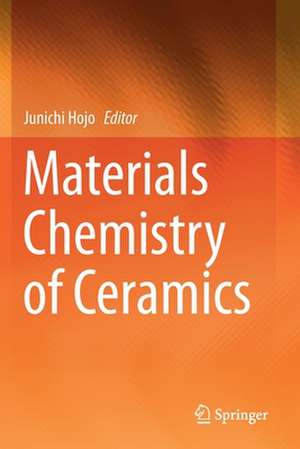Materials Chemistry of Ceramics
Editat de Junichi Hojoen Limba Engleză Paperback – 26 noi 2020
This book provides fundamental knowledge of ceramics science and technology in a compact volume. Based on inorganic chemistry, it is intended as a reader for graduate students and young researchers beginning work in ceramics. The importance of the book is that it provides a scientific understanding of structure, properties, and processing from the chemical aspect, leading to creation of future ceramics. Ceramics have high hardness, strength, thermal and chemical stability, as well as various electromagnetic functions. To take full advantage of ceramics, their use has been advanced to engineering and electronic ceramics. Most ceramics have been fabricated by powder processing, and new technologies have also evolved such as CVD and sol-gel methods: new ceramics aimed at new functions of highly pure oxides and artificial nitrides, carbides, and borides; fine ceramics focused on precise control of composition and microstructure; and design of unique morphology, such as nanoparticles,nanofibers, nanosheets, mesoporous materials, and hybrids. Materials are composed of atoms and molecules. They are assembled into crystals and are amorphous, leading to 3-D micro/nano structures. In addition to the topics described above, this book shows the importance of chemistry for materials design at the nanometer scale, and that chemistry develops new fields of environment, energy, informatics, biomaterials, and other areas.
| Toate formatele și edițiile | Preț | Express |
|---|---|---|
| Paperback (1) | 694.22 lei 6-8 săpt. | |
| Springer Nature Singapore – 26 noi 2020 | 694.22 lei 6-8 săpt. | |
| Hardback (1) | 947.98 lei 6-8 săpt. | |
| Springer Nature Singapore – 26 noi 2019 | 947.98 lei 6-8 săpt. |
Preț: 694.22 lei
Preț vechi: 816.73 lei
-15% Nou
Puncte Express: 1041
Preț estimativ în valută:
132.84€ • 144.75$ • 111.94£
132.84€ • 144.75$ • 111.94£
Carte tipărită la comandă
Livrare economică 23 aprilie-07 mai
Preluare comenzi: 021 569.72.76
Specificații
ISBN-13: 9789811399374
ISBN-10: 9811399379
Pagini: 233
Ilustrații: X, 233 p. 151 illus., 61 illus. in color.
Dimensiuni: 155 x 235 mm
Greutate: 0.35 kg
Ediția:1st ed. 2019
Editura: Springer Nature Singapore
Colecția Springer
Locul publicării:Singapore, Singapore
ISBN-10: 9811399379
Pagini: 233
Ilustrații: X, 233 p. 151 illus., 61 illus. in color.
Dimensiuni: 155 x 235 mm
Greutate: 0.35 kg
Ediția:1st ed. 2019
Editura: Springer Nature Singapore
Colecția Springer
Locul publicării:Singapore, Singapore
Cuprins
1. Crystal Structures of Inorganic Materials.- 2. Phase Equilibrium and Phase Diagram.- 3. Solid State Reactions and Sintering.- 4. Powder and Thin Film Synthesis.- 5. Chemical Functions of Ceramics.- 6. Biological Functions of Ceramics.- 7. Mechanical Property of Ceramics.- 8. Electromagnetic Properties of Ceramics.- 9. Optical Properties of Ceramics.- 10. Organic-Inorganic Hybrid Materials.
Notă biografică
Junichi Hojo received his Ph.D. in engineering from Kyushu University (Japan) in 1980. He became a professor there in 1994 and emeritus professor in 2013. From 2006 to 2010 he was Vice-President of the Ceramic Society of Japan and was Editor of Materials Letters (Elsevier) from 2006 to the present. Prof. Hojo served on the Advisory Board of the World Academy of Ceramics from 2010 to 2014, was a Fellow of the American Ceramic Society in 2010, and Vice-President of the Japan Society of Powder and Powder Metallurgy from 2014 to 2016. His major research work is in the design of ceramics nanoparticles and their functions, and the precise control of sintered microstructures.
Textul de pe ultima copertă
This book provides fundamental knowledge of ceramics science and technology in a compact volume. Based on inorganic chemistry, it is intended as a reader for graduate students and young researchers beginning work in ceramics. The importance of the book is that it provides a scientific understanding of structure, properties, and processing from the chemical aspect, leading to creation of future ceramics. Ceramics have high hardness, strength, thermal and chemical stability, as well as various electromagnetic functions. To take full advantage of ceramics, their use has been advanced to engineering and electronic ceramics. Most ceramics have been fabricated by powder processing, and new technologies have also evolved such as CVD and sol-gel methods: new ceramics aimed at new functions of highly pure oxides and artificial nitrides, carbides, and borides; fine ceramics focused on precise control of composition and microstructure; and design of unique morphology, such as nanoparticles, nanofibers, nanosheets, mesoporous materials, and hybrids. Materials are composed of atoms and molecules. They are assembled into crystals and are amorphous, leading to 3-D micro/nano structures. In addition to the topics described above, this book shows the importance of chemistry for materials design at the nanometer scale, and that chemistry develops new fields of environment, energy, informatics, biomaterials, and other areas.
Caracteristici
Provides knowledge of ceramics quickly in a compact volume Includes an easy-to-understand introduction of the functions and properties of practical ceramics for the how and why of using ceramic materials Presents the chemical aspect for understanding the meaning of ceramics structure and processing and for creating new ceramics at the nanometer level
